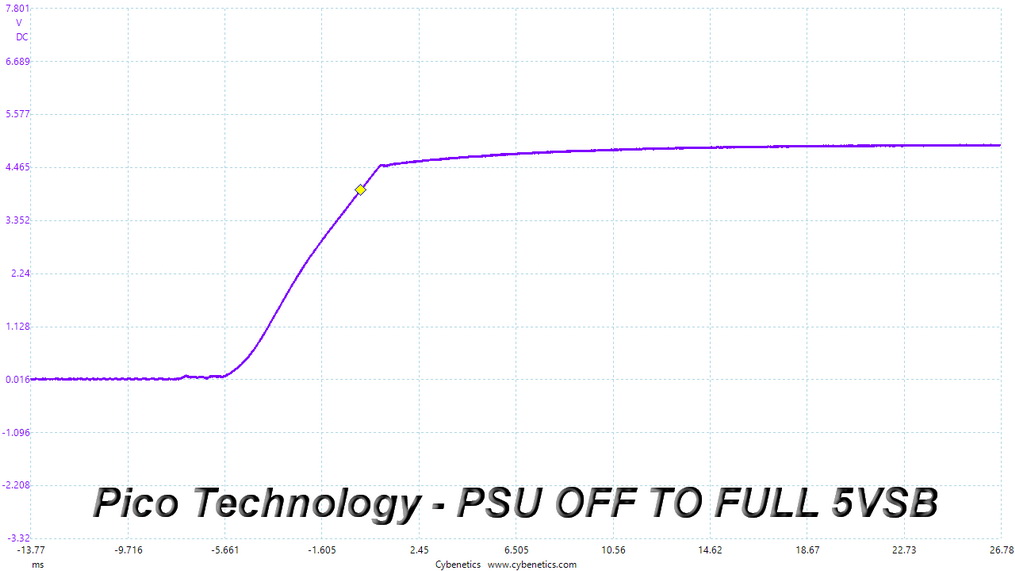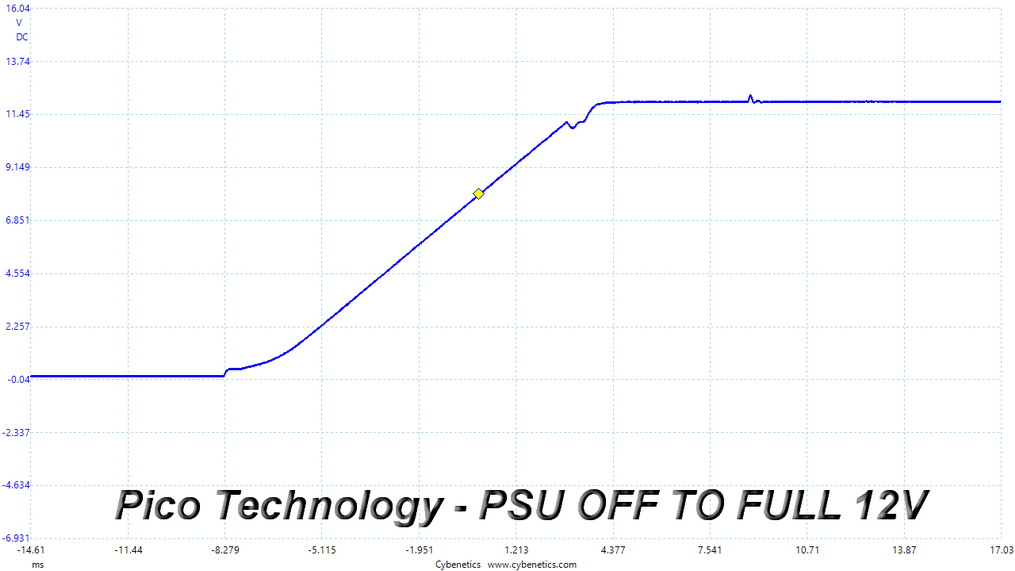Why you can trust Tom's Hardware
Advanced Transient Response Tests
For details about our transient response testing, please click here.
In the real world, power supplies are always working with loads that change. It's of immense importance, then, for the PSU to keep its rails within the ATX specification's defined ranges. The smaller the deviations, the more stable your PC will be with less stress applied to its components.
We should note that the ATX spec requires capacitive loading during the transient rests, but in our methodology, we also choose to apply a worst case scenario with no additional capacitance on the rails.
Advanced Transient Response at 20% – 20ms
| Voltage | Before | After | Change | Pass/Fail |
|---|---|---|---|---|
| 12V | 12.025V | 11.845V | 1.50% | Pass |
| 5V | 5.080V | 4.993V | 1.71% | Pass |
| 3.3V | 3.336V | 3.216V | 3.60% | Pass |
| 5VSB | 5.077V | 5.030V | 0.93% | Pass |
Advanced Transient Response at 20% – 10ms
| Voltage | Before | After | Change | Pass/Fail |
|---|---|---|---|---|
| 12V | 12.030V | 11.673V | 2.97% | Pass |
| 5V | 5.080V | 4.995V | 1.67% | Pass |
| 3.3V | 3.337V | 3.219V | 3.54% | Pass |
| 5VSB | 5.077V | 5.013V | 1.26% | Pass |
Advanced Transient Response at 20% – 1ms
| Voltage | Before | After | Change | Pass/Fail |
|---|---|---|---|---|
| 12V | 12.033V | 11.495V | 4.47% | Pass |
| 5V | 5.080V | 5.000V | 1.57% | Pass |
| 3.3V | 3.337V | 3.221V | 3.48% | Pass |
| 5VSB | 5.076V | 5.036V | 0.79% | Pass |
Advanced Transient Response at 50% – 20ms
| Voltage | Before | After | Change | Pass/Fail |
|---|---|---|---|---|
| 12V | 12.023V | 11.847V | 1.46% | Pass |
| 5V | 5.073V | 4.987V | 1.70% | Pass |
| 3.3V | 3.327V | 3.200V | 3.82% | Pass |
| 5VSB | 5.026V | 4.974V | 1.03% | Pass |
Advanced Transient Response at 50% – 10ms
| Voltage | Before | After | Change | Pass/Fail |
|---|---|---|---|---|
| 12V | 12.029V | 11.838V | 1.59% | Pass |
| 5V | 5.074V | 4.981V | 1.83% | Pass |
| 3.3V | 3.327V | 3.202V | 3.76% | Pass |
| 5VSB | 5.026V | 4.974V | 1.03% | Pass |
Advanced Transient Response at 50% – 1ms
| Voltage | Before | After | Change | Pass/Fail |
|---|---|---|---|---|
| 12V | 12.032V | 11.800V | 1.93% | Pass |
| 5V | 5.074V | 4.988V | 1.69% | Pass |
| 3.3V | 3.327V | 3.203V | 3.73% | Pass |
| 5VSB | 5.025V | 4.953V | 1.43% | Pass |

Results 25-29: Transient Response







We would like to see lower deviations at +12V with 100Hz and 1000Hz load repetition rates, with 20% starting load. At the higher starting load level, which is 50%, voltage drops at +12V are in control, since the primary switching FETs operate in FM mode.
Turn-On Transient Tests
In the next set of tests, we measure the PSU's response in simpler transient load scenarios—during its power-on phase. Ideally, we don't want to see any voltage overshoots or spikes since those put a lot of stress on the DC-DC converters of installed components.

Turn-On Transient Response Scope Shots


Very good results here.
Power Supply Timing Tests
There are several signals generated by the power supply, which need to be within specified, by the ATX spec, ranges. If they are not, there can be compatibility issues with other system parts, especially mainboards. From year 2020, the PSU's Power-on time (T1) has to be lower than 150ms and the PWR_OK delay (T3) from 100 to 150ms, to be compatible with the Alternative Sleep Mode.
Get Tom's Hardware's best news and in-depth reviews, straight to your inbox.
| T1 (Power-on time) & T3 (PWR_OK delay) | ||
|---|---|---|
| Load | T1 | T3 |
| 20% | 82ms | 278ms |
| 100% | 82ms | 292ms |
The PWR_OK delay is out of the 100-150ms region, so the PSU does not support the alternative sleep mode, which is recommended by the ATX spec. Although this is not a major problem, since there are no compatible mainboards, yet, still it would be nice to provide ASM compatibility.
Ripple Measurements
Ripple represents the AC fluctuations (periodic) and noise (random) found in the PSU's DC rails. This phenomenon significantly decreases the capacitors' lifespan because it causes them to run hotter. A 10-degree Celsius increase can cut into a cap's useful life by 50%. Ripple also plays an important role in overall system stability, especially when overclocking is involved.
The ripple limits, according to the ATX specification, are 120mV (+12V) and 50mV (5V, 3.3V, and 5VSB).
| Test | 12V | 5V | 3.3V | 5VSB | Pass/Fail |
| 10% Load | 11.7 mV | 11.5 mV | 15.0 mV | 4.2 mV | Pass |
| 20% Load | 12.3 mV | 11.8 mV | 14.5 mV | 4.9 mV | Pass |
| 30% Load | 12.8 mV | 12.6 mV | 15.0 mV | 5.8 mV | Pass |
| 40% Load | 15.8 mV | 13.4 mV | 15.2 mV | 6.9 mV | Pass |
| 50% Load | 15.2 mV | 14.7 mV | 18.2 mV | 8.2 mV | Pass |
| 60% Load | 16.1 mV | 16.9 mV | 18.0 mV | 10.1 mV | Pass |
| 70% Load | 16.3 mV | 17.9 mV | 19.0 mV | 10.9 mV | Pass |
| 80% Load | 16.9 mV | 18.1 mV | 17.4 mV | 12.0 mV | Pass |
| 90% Load | 17.6 mV | 20.1 mV | 19.4 mV | 11.8 mV | Pass |
| 100% Load | 23.8 mV | 23.1 mV | 21.4 mV | 13.7 mV | Pass |
| 110% Load | 24.7 mV | 24.7 mV | 23.2 mV | 15.0 mV | Pass |
| Crossload 1 | 16.5 mV | 15.0 mV | 19.7 mV | 6.3 mV | Pass |
| Crossload 2 | 23.5 mV | 22.1 mV | 19.8 mV | 11.1 mV | Pass |

Results 30-33: Ripple Suppression



Ripple suppression is not the best we have seen, especially on the minor rails, but this doesn't mean that it isn't at good enough levels. It is just that the competition, from CWT and Seasonic mostly, set the bar too high in this metric.
Ripple At Full Load

Ripple Full Load Scope Shots



Ripple At 110% Load

Ripple 110% Load Scope Shots



Ripple At Cross-Load 1

Ripple CL1 Load Scope Shots



Ripple At Cross-Load 2

Ripple CL2 Load Scope Shots



EMC Pre-Compliance Testing – Average & Quasi-Peak EMI Detector Results
Electromagnetic Compatibility (EMC) is the ability of a device to operate properly in its environment without disrupting the proper operation of other nearby devices.
Electromagnetic Interference (EMI) stands for the electromagnetic energy a device emits, and it can cause problems in other nearby devices if too high. For example, it can be the cause of increased static noise in your headphones or/and speakers.
There are several high EMI spurs, below 1MHz.
MORE: Best Power Supplies
MORE: How We Test Power Supplies
MORE: All Power Supply Content
Current page: Transient Response Tests, Timing Tests, Ripple Measurements and EMC Pre-Compliance Testing
Prev Page Protection Features, DC Power Sequencing, Cross-Load Tests and Infrared Images Next Page Performance, Noise, Efficiency and Power Factor
Aris Mpitziopoulos is a contributing editor at Tom's Hardware, covering PSUs.
-
bdcrlsn I know they're not actually made by Thermaltake, but I've had a Toughpower 650-watt for 7 years and had no issues whatsoever. They're good choices these days in a saturated market.Reply -
Braindead154 I bought two of these power supplies to use in my new rig. BOTH of them had a high pitched whine when my computer was off or sleeping (MSI MEG x570 Unify). As much as I appreciated the long warranty and build quality, I prefer not to have a dog whistle in my PC case. They were returned.Reply
